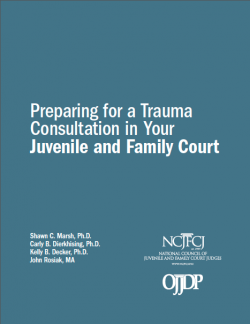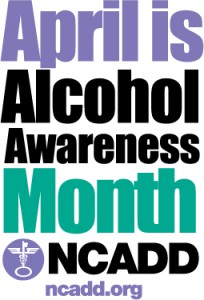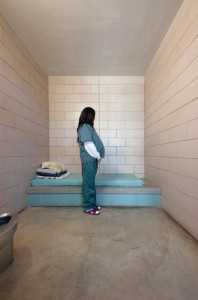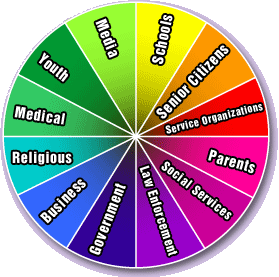Juvenile Justice in America: We Can Do Better; News Roundup
By Bridget Murphy, April 17 2015
 Juvenile Justice Reform
Juvenile Justice Reform
Topics: News
By Bridget Murphy, April 17 2015
 Juvenile Justice Reform
Juvenile Justice Reform
Topics: News
By Susan Richardson, April 16 2015
A growing body of research is constantly giving fuel to the issue of childhood trauma and toxic  stress—specifically, how they impact health outcomes in the future, and the critical need for juvenile and family courts to become trauma-informed in order to effectively treat these issues. The latest effort to make trauma-informed courts widespread is from the National Council of Juvenile and Family Court Judges (NCJFCJ), which has released “Preparing for a Trauma Consultation in Your Juvenile and Family Court,” a guide for juvenile and family courts to become more trauma-informed.
stress—specifically, how they impact health outcomes in the future, and the critical need for juvenile and family courts to become trauma-informed in order to effectively treat these issues. The latest effort to make trauma-informed courts widespread is from the National Council of Juvenile and Family Court Judges (NCJFCJ), which has released “Preparing for a Trauma Consultation in Your Juvenile and Family Court,” a guide for juvenile and family courts to become more trauma-informed.
The guide outlines why courts need to be trauma-informed and how they approach building a framework, including:
ACEs Too High, an online news site dedicated to adverse childhood experiences (ACEs), regularly reports on the need for more trauma-informed courts that are reflected in this NCJFCJ guide. A recent article by writer Ed Finkel reports on local courts who are adopting models of trauma-informed care, and other tools available, such as the Think Trauma curriculum for staff members in juvenile correctional facilities.
Finkel also reported on the trauma-informed approach used by judges to administer sustainable solutions for at-risk youth. The article interviews several judges to gain their perspective on trauma-informed courts.
Most recently, Pediatrician and ACEs leader Nadine Burke Harris brought ACEs to the forefront once again on a national stage during her TEDMED talk emphasizing the health impact of childhood trauma, indicating that those who have experienced high levels of this kind of toxic stress are four times more likely to become depressed, and 12 times more likely to attempt suicide.
The NCJFCJ guide is more timely than ever, as more and more public health leaders are adding to existing evidence that emphasizes the need for trauma-informed care. A trauma-informed court can be a safe and effective point of intervention to vulnerable youth and families, and can help coordinate support or treatment to improve outcomes and get young people on a positive path.
By Christa Myers, April 14 2015
 Below you’ll find a selection of the latest grants, jobs, webinars and events posted to our Opportunity Board. Please share the Reclaiming Futures Opportunity Board with your colleagues in the juvenile justice, adolescent substance abuse and teen mental health areas. It’s free to browse and post!
Below you’ll find a selection of the latest grants, jobs, webinars and events posted to our Opportunity Board. Please share the Reclaiming Futures Opportunity Board with your colleagues in the juvenile justice, adolescent substance abuse and teen mental health areas. It’s free to browse and post!
By Cecilia Bianco, April 13 2015
 Cambiar, the Spanish word for change, was appropriately chosen as the name of a program in New Mexico that is attempting to transform the juvenile justice system and the young people in the system along with it.
Cambiar, the Spanish word for change, was appropriately chosen as the name of a program in New Mexico that is attempting to transform the juvenile justice system and the young people in the system along with it.
Featured in a recent Daily Beast article “How to Curb Our Mass Incarceration Epidemic,” the Cambiar program at the J. Paul Taylor Center focuses on reform over punishment for inmates, who the center refers to as “clients.”
This transformation to reform, rather than punish, is modeled after Missouri’s juvenile justice system where most teen offenders are in prison schools or work programs, with access to family therapy. Reports indicate that 75 percent of Missouri’s youthful offenders get a year of education each year they are incarcerated—three times the national average. This has led to a startling improvement: 65 percent of offenders in that system are not rearrested within three years of release.
The Cambiar program is aiming for the same positive results—all of its clients have access to education and mentors, something that Reclaiming Futures champions, implements and sees results with:
“The staff here mentors students, teaches real high school classes, provides a clear system of rewards and punishments that excludes extreme approaches like solitary confinement—all tactics that resulted from a 2006 agreement with the ACLU that sheds light on systematic abuses endemic in juvenile systems.”
The Center also strives to provide an environment that nurtures positive peer culture, with the teens learning to do everything together as a unit. Having a support system, the Center believes, is key towards reforming young people:
“They [the Taylor Center] changed to smaller units where the kids were in groups of 12 rather than in large pods. They worked toward regionalization to try to get the kids closer to their families so they could have support from their families,” Sandra Stewart, director of Juvenile Justice Services in New Mexico, said.
Stewart also emphasized that the transformation of the Taylor Center is due to its focus on learning, mental health counseling, and mentoring over lockdowns and punishments.
The author of this article, Soledad O’Brien, interviewed several clients at the Taylor Center as part of her documentary film “Kids Behind Bars,” which airs Sunday, April 12 at 7 p.m. PST on Al Jazeera America:
“’Honestly, like, I've always liked to learn. It was always there but I never actually took the time to sit down. I never had the will. I never had someone to push me and when I came here, like I said, some staff here helped me out with that,” he said. Since I interviewed him, he got out and has completed a 90-day probationary period.”
Learn more about the Cambiar program on the State of New Mexico Children, Youth and Families Department (CYFD) website.
Topics: Juvenile Justice Reform
By Christa Myers, April 10 2015
 Juvenile Justice Reform
Juvenile Justice Reform
Topics: News
By Jim Carlton, April 08 2015
Susan Richardson has recently announced her plans to leave the position of national executive director of Reclaiming Futures to return to her home state of North Carolina, and we are grateful for her years of excellent leadership. Yesterday, Reclaiming Futures appointed Mr. Evan Elkin as national executive director, effective May 11, 2015.
By Bridget Murphy, April 07 2015
 Below you’ll find a selection of the latest grants, jobs, webinars and events posted to our Opportunity Board. Please share the Reclaiming Futures Opportunity Board with your colleagues in the juvenile justice, adolescent substance abuse and teen mental health areas. It’s free to browse and post!
Below you’ll find a selection of the latest grants, jobs, webinars and events posted to our Opportunity Board. Please share the Reclaiming Futures Opportunity Board with your colleagues in the juvenile justice, adolescent substance abuse and teen mental health areas. It’s free to browse and post!
Webinars
Topics: Opportunity Board
By Cecilia Bianco, April 06 2015
 There are 2.5 million alcohol-related deaths worldwide every year. Approximately nine percent, or 320,000 of those deaths, are among young people aged 15-29.
There are 2.5 million alcohol-related deaths worldwide every year. Approximately nine percent, or 320,000 of those deaths, are among young people aged 15-29.
April is Alcohol Awareness Month, and there are many ways to get involved to help create awareness and encourage individuals and families to get help for alcohol-related problems.
The National Council on Alcoholism and Drug Dependence (NCADD) has sponsored Alcohol Awareness Month every April since 1987 and provides all the information and resources you’ll need to support this cause.
The theme for this year’s 2015 NCADD Alcohol Awareness Month was chosen to highlight the pervasive impact that alcohol, alcohol-related problems and alcoholism have on individuals, on families and children, in the workplace and in our communities: "For the Health of It: Early Education on Alcoholism and Addiction."
The NCADD provides many resources that help bring light to this issue and we are all encouraged to share them widely:
Drinking Too Much Too Fast Can Kill You
NCADD's Self-Test for Teenagers
Local NCADD Affiliates as well as schools, colleges, churches, and countless other community organizations will sponsor a host of activities to support this cause.
Many organizations have already joined in and are doing their part to raise awareness, including the following:
If you’re interested in hosting an event or spreading the word, NCADD also has an “Organizer’s guide” to make it easy and effective in your community! The Organizer’s guide includes:
For more information, visit the NCADD website.
By Christa Myers, April 03 2015
 Juvenile Justice Reform
Juvenile Justice Reform
Topics: News
By Anonymous, March 31 2015
 Below you’ll find a selection of the latest grants, jobs, webinars and events posted to our Opportunity Board. Please share the Reclaiming Futures Opportunity Board with your colleagues in the juvenile justice, adolescent substance abuse and teen mental health areas. It’s free to browse and post!
Below you’ll find a selection of the latest grants, jobs, webinars and events posted to our Opportunity Board. Please share the Reclaiming Futures Opportunity Board with your colleagues in the juvenile justice, adolescent substance abuse and teen mental health areas. It’s free to browse and post!
Webinars
Topics: Resources
By Bridget Murphy, March 30 2015
The National Association of State Alcohol and Drug Abuse Directors, Inc. (NASADAD) “…purpose is to foster and support the development of effective alcohol and other drug abuse prevention and treatment programs throughout every State.” NASADAD has recently achieved this purpose by the development of the State Adolescent Substance Use Disorder Treatment and Recovery Practice Guide (see link below).
By Cecilia Bianco, March 30 2015
 The Center for Juvenile Justice Reform (CJJR) at Georgetown University‘s McCourt School of Public Policy has announced that the application window for the 2015 Reducing Racial and Ethnic Disparities in Juvenile Justice Certificate Program is now open through May 15, 2015.
The Center for Juvenile Justice Reform (CJJR) at Georgetown University‘s McCourt School of Public Policy has announced that the application window for the 2015 Reducing Racial and Ethnic Disparities in Juvenile Justice Certificate Program is now open through May 15, 2015.
The Reducing Racial and Ethnic Disparities in Juvenile Justice Certificate Program, held August 3-7, 2015, is an intensive training designed to support local jurisdictions in their efforts to reduce racial and ethnic disparities in their juvenile justice systems. The program is operated jointly by the Georgetown Center for Juvenile Justice Reform and the Center for Children's Law and Policy.
The three primary goals of the certificate program are to help jurisdictions reduce:
Through the examination of the key decision points in the juvenile justice system, the program’s curriculum provides participants a better understanding of the disparate treatment of youth of color may be experiencing as compared to white youth within the juvenile justice system.
The program will also focus on the relationship between disproportionality in the juvenile justice system and disparate treatment in other child serving systems, including child welfare and education.
After completing the program, participants will be responsible for the development of a capstone project – a set of actions each participant will design and undertake within their organization or community to initiate or continue collaborative efforts to reduce racial and ethnic disparities in the juvenile justice system.
Visit the CJJR website where you will find further information about the program, including how to apply, tuition, and available subsidies for those with financial need. Questions can be sent to jill.adams@georgetown.edu.
By Anonymous, March 27 2015
 Juvenile Justice Reform
Juvenile Justice Reform
Topics: News
By Susan Richardson, March 26 2015
Emerging leaders age 17-25 interested in juvenile justice reform will convene at the 2015 Juvenile Justice Youth Summit, co-hosted by The Coalition for Juvenile Justice (CJJ) and the Office of Juvenile Justice and Delinquency Prevention (OJJDP) (OJJDP).
The two-day summit—"The Time is Now: Creating Change with Young Emerging Leaders"—takes place July 23-24, 2015 in Washington, DC.
According to the event announcement, “these next generation leaders gain a better understanding of the current juvenile justice system, examine trending reform topics, and participate in various skill-building, hands-on activities.” Agenda topics include: juvenile justice 101; keeping young people out of adult courts, jails, and prisons; and positive youth development. Additional interactive activities will connect these young leaders with key influencers:
Help identify emerging leaders in juvenile justice, and encourage them to register for the 2015 Juvenile Justice Youth Summit. We can help foster the next generation of leaders who will ultimately impact the future of juvenile justice.
Registration Details
Registration is now open. Register by April 30 for get the early bird discount rate.
Accommodations
All participants that register during the early registration period or using the non-member rate will receive a complimentary CJJ membership.
CJJ has a room block reserved at The Liaison Hotel for $189/night. To make your reservation you can call (866) 233-4642 or click here. Please reference the "Coalition for Juvenile Justice" group when making reservations or provide the following reservation ID: 15CJJ.
Questions?
Contact Jonathan Litt, CJJ's Field Relations Associate, at litt@juvjustice.org.
By Jim Carlton, March 24 2015
 Below you’ll find a selection of the latest grants, jobs, webinars and events posted to our Opportunity Board. Please share the Reclaiming Futures Opportunity Board with your colleagues in the juvenile justice, adolescent substance abuse and teen mental health areas. It’s free to browse and post!
Below you’ll find a selection of the latest grants, jobs, webinars and events posted to our Opportunity Board. Please share the Reclaiming Futures Opportunity Board with your colleagues in the juvenile justice, adolescent substance abuse and teen mental health areas. It’s free to browse and post!
Webinars
By jcarlton, March 23 2015
Translational research is concerned with moving basic (“bench”) research to clinical and ultimately practical benefit (“bedside”). If research can in fact demonstrate beneficial outcomes, then it may even lead to policy changes.
Topics: Evidence-Based Practices, Juvenile Court, research
By Cecilia Bianco, March 23 2015

Approximately 30 percent of the country’s incarcerated youth are young girls—a rapidly growing group whose needs are not being met, according to significant research and practice indicating the juvenile justice system is catered towards boys.
Photographer Richard Ross has sought to display this through images. Over the past eight years, Ross has visited more than 200 facilities in 34 states and been given rare access to interview and photograph more than 1,000 young people in detention.
His work has resulted in two books Juvenile in Justice and the more recently released Girls in Justice—a close look at the daily lives of young women in juvenile facilities.

PBS NewsHour recently interviewed Ross on his latest collection of powerful photos, sharing a photo essay with commentary from Ross:
Ross said most of the young females he interviewed had remarkably similar stories. Few had committed serious crimes, and many had been the victims of either sexual or physical abuse before their arrest…
The stories he’s heard have been heartwrenching. Among countless stories of physical, sexual and emotional abuse, one 14 year-old girl recounted being raped at age 3, another admitted to being suicidal.
When asked what surprised Ross most about his project, he didn’t hesitate: “How many times I’ve cried,” he said.
See the full photo essay and interview on PBS.
Topics: Juvenile Justice Reform, News
By Cecilia Bianco, March 20 2015
 Juvenile Justice Reform
Juvenile Justice Reform
Jobs, Grants, Events and Webinars
Adolescent Substance Abuse Treatment and Mental Health
By Bridget Murphy, March 19 2015
We live in the information age. Reclaiming Futures sites and other jurisdictions engaged in similar focused reform efforts have access to information from multiple sources and disciplines such as: web-sites; journal articles, news; juvenile justice, behavioral health, psychology, sociology, education, social work, medicine and so on.
So how do we critically assess these sources of information? Let’s discuss by using an example.
By Susan Richardson, March 19 2015
Youth violence in the U.S. is the third leading cause of death for young people between the ages of 15 and 24—one of the many reasons National Youth Violence Prevention Week seeks to educate students, teachers, school staff, parents, and the public on effective ways to prevent or reduce youth violence.
of 15 and 24—one of the many reasons National Youth Violence Prevention Week seeks to educate students, teachers, school staff, parents, and the public on effective ways to prevent or reduce youth violence.
Taking place next week, March 23-27, 2015, Youth Violence Prevention Week is founded by The National Association of Students Against Violence Everywhere (SAVE). The initiative kicks off with the 15th SAVE Summit March 21, and expands nationally next week to encourage communities to host events and workshops engaging students in the fight to stop shootings, bullying and other violence in our schools using the planning tools and resources in SAVE’s Action Kit.
According to SAVE, violence in schools has become devastatingly common in the United States (statistics sourced from the Center for Disease Control and Prevention):
During the week of March 23-27, SAVE will offer activity ideas for schools and community organizations across the country to host events educating youth on the potential of their positive impacts on their communities. Below are a list of events produced by SAVE and its sponsors:

Visit the National Youth Violence Prevention Week website for an activity planning guide, as well as suggested ideas targeted at specific audiences involved in young people’s lives (ie: parents, school, senior citizens, law enforcement, medical services, etc.)
Topics: Positive Youth Development, Resources